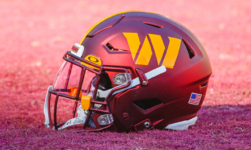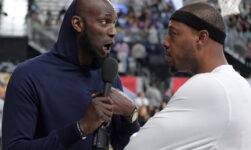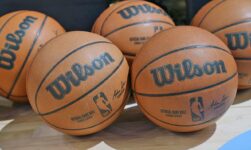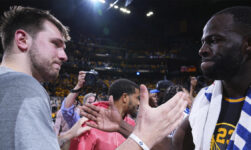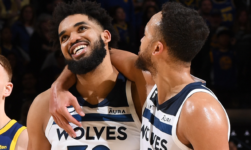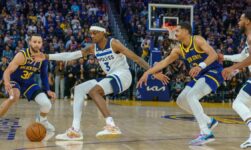The 2020 NBA Draft is over, so it’s time to prematurely evaluate an evening of decisions that were largely about projecting how good 19- and 20-year-olds will be in three to five years. That’s right: Let’s look at the winners and losers of the draft.
A disclaimer: This is not meant to be a definitive assessment of the quality of each pick. It is more of a look at the ramifications of draft night, what made sense and what was confusing. You can find individual grades for each pick on our draft tracker.
Winner: Philadelphia 76ers
Before the draft began, Philadelphia balanced its roster and significantly improved its short- and long-term flexibility in one fell swoop. Out went Al Horford and his enormous contract, in came Danny Green, Terrance Ferguson and an $8.6 million trade exception. This cost the Sixers a first-round pick, a second-round pick and the rights to Vasilje Micic.
Merely salary-dumping Horford would have been challenging, but Daryl Morey’s front office managed to add a player who fits perfectly next to the Sixers’ stars. Green will be a part of some dominant defensive lineups this coming season, and when his contract expires next summer Philadelphia will have options it wouldn’t have had with Horford on the books.
Green is also a clear winner. He’s the only player in the NBA coming off back-to-back titles, and instead of spending half a season on a rebuilding Oklahoma City Thunder team, wondering where he’d go at the trade deadline, he’s headed to a contender close to home.
And then there was draft night itself: At No. 21, the Sixers drafted Tyrese Maxey, a strong, defensive-minded guard who could be an absolute steal if he develops into as good of a shooter as his free throw percentage suggests he will. Then they traded Josh Richardson and the No. 36 pick to the Dallas Mavericks for Seth Curry, whose stellar shooting and secondary playmaking are desperately needed in Philadelphia.
At No. 49, the Sixers selected Isaiah Joe, who makes sense on this roster for one screamingly obvious reason. Yes, you guessed it: Joe is an elite shooter.
Finally, with the No. 58 pick, the Sixers drafted Paul Reed, a long and athletic big man who just happens to be an analytics darling. Players with his upside are typically not available that late in the draft.
Loser: Golden State Warriors, and maybe all of us
This isn’t about James Wiseman, although I admit I’m not nearly as high on him as Golden State is. The Warriors were clearly unable to move the No. 2 pick for a star, and now they’re effectively banking on the 19-year-old center realizing his upside before their championship window slams shut.
In much worse news, Klay Thompson suffered a leg injury of undetermined severity mere hours before the draft. Thompson has spent the last 17 months working his way back from a torn ACL and was set to return to the court in a number of weeks. Now the Warriors fear that he has injured his Achilles.
Last season was supposed to be a “gap year” for Golden State, a detour into irrelevance before a swift return to championship contention. Stephen Curry will turn 33 this season, and Draymond Green and Thompson will both turn 31. It is within the realm of possibility that Thompson’s leg will be fine and Wiseman will be immediately capable of performing in the playoffs (or traded for someone who is), but it’s also possible that Thompson will be out for the year and Wiseman will be a project. The worst-case scenario here is a total bummer, not just for the Warriors but for all of us looking forward to them being back in the mix.
Winner: De’Aaron Fox
I can’t believe Tyrese Haliburton dropped all the way to the Kings at No. 12. He’s precisely the kind of prospect that they, and specifically Fox, must have been hoping for. As a playmaker, Haliburton will relieve Fox of the pressure to do everything, but he won’t force Fox off the ball. Combine that with his shooting range and ability to make plays on defense and it is difficult to imagine a more ideal backcourt partner.
Beyond all that, Haliburton is a connector. He is an extremely skilled and enthusiastic passer, and his defensive instincts are phenomenal, which is not something I can say about any of Sacramento’s other core players. The Kings should be ecstatic about having him in the organization.
Loser: The teams that let Haliburton and Vassell slip
It wasn’t just Haliburton. Directly before Sacramento stole him, the San Antonio Spurs selected Devin Vassell, a 3-and-D guy who could have helped several teams that picked higher. The No. 11 pick has earned Danny Green comparisons because of his off-ball defense and accurate shooting so, of course, he’s a Spur.
Winner: The Theoretical Thunder
First, the Horford-Green trade gave the Thunder the No. 34 pick, which they used on 19-year-old French prospect Theo Maledon, a big point guard who idolizes Tony Parker and, in typical Thunder fashion, needs to improve his 3-point shot and get stronger. Oklahoma City also received a 2025 first-round pick in the deal.
Sam Presti’s front office then traded the newly acquired Ricky Rubio to the Minnesota Timberwolves along with picks No. 25 and 28 in exchange for the No. 17 pick. They used that on one of the most intriguing and downright weird prospects in NBA Draft history, Serbian 7-footer Aleksej Pokusevski. He’s the youngest and easily the skinniest player in the draft, and there is no real way to compare him to anyone. The dude passes like a guard, moves like a wing and blocks shots like a big man, but he weighs around 200 pounds and can’t take contact at all.
Pokusevski is a more than worthy gamble for a rebuilding Thunder team that is accumulating assets like crazy. I understand if you’re sick of all the Presti praise — it’s easier to tear down a team than build one — but, right now, Oklahoma City’s hoard of future picks represents limitless possibility. So does Pokusevski.
Loser: Onyeka Okongwu
It’s hard to say going No. 6 is a bad outcome for Okongwu, Atlanta’s new rim-running and rim-protecting center. Unless the Hawks move Clint Capela before he plays a single game for them, though, his pathway to major minutes is blocked for the time being. This is a particularly weird fit because it makes it harder to find John Collins any minutes at all at the 5.
To be clear: Atlanta isn’t a loser for making the pick. I expect Okongwu to be the best center in the draft, and there’s nothing wrong with picking based on talent and figuring out your big man rotation later. It’s just disappointing to see such a good prospect wind up on a team that doesn’t really need someone like him.
Winner: Memphis Grizzlies
I can’t help but think a bunch of teams outsmarted themselves by passing on Desmond Bane. A year after pleasing draft nerds by trading up for Brandon Clarke at No. 21, they nabbed the 30th pick from Boston and used it on Bane, another internet favorite. Bane is a straight-up tank who shot better than 40 percent from 3-point range in three of his four seasons at TCU, plays heady defense and presumably slipped because he’s 22 years old and has short arms.
Almost no rookies actually help teams win right away, but Bane is the rare prospect who very well might. He fits beautifully with Memphis’ core of Ja Morant, Brandon Clarke and Jaren Jackson Jr., and, given how much leeway Dillon Brooks had as a creator last season, this seems like a team that will allow him to keep developing as a playmaker. Bane is a creative passer, and ideally, he’ll be more than a 3-and-D guy in the NBA.
But that’s not all. With the No. 35 pick, the Grizzlies grabbed Xavier Tillman, another extremely physical and productive prospect. Tillman is 21 years old and looks much older, and Morant is going to love his screens. He’s a good passer, too, and was a downright dominant defender for Michigan State.
Loser: Terry Rozier and/or Devonte’ Graham
LaMelo Ball is now the face of the Charlotte Hornets, which has to be pretty weird for Terry Rozier. In the summer of 2019, Rozier joined the Hornets in a sign-and-trade deal, expecting to be their starting point guard. Instead, he wound up sharing the backcourt with breakout guard Devonte’ Graham, and now neither of them will be the lead playmaker.
There’s a case to be made for keeping one of Graham or Rozier around. Both of them can shoot, Ball has wing size and Rozier has wing length. Bringing back all three seems like a misallocation of resources, though, and Ball needs to be running the show when he’s on the court.
Related: The Hornets are winners for drafting Ball regardless of need, and D’Angelo Russell is a winner because the Minnesota Timberwolves passed on him to take bucket-getter Anthony Edwards with the No. 1 pick. Russell and Ball would’ve been an awkward combination.
Winner: Patrick Williams
Williams had been rumored to be rising for some time, but it was still sort of shocking to see the Chicago Bulls take him at No. 4. There was lots of discussion about him not starting a single game in college, as if that means that he is destined to be nothing more than a role player. The very reason he went this high, though, is that he is an insane athlete who has convinced the Bulls — and, if recent reports are to be believed, other teams in the top 10 — that he’s a good bet to develop his skills and become something special.
Loser: Minnesota’s defense
Karl-Anthony Towns, Russell and Edwards could be a fearsome trio … on offense. Unfortunately for the Wolves, that’s only half the game. I would love for these three to collectively prove me wrong here, but their track records suggest that Minnesota’s front office and coaching staff are going to have to contort themselves to cover up this glaring deficiency.
Winner: Jalen Smith
Smith is the winner of this year’s Cameron Johnson Award for the most stunning pick of the lottery, and he’s going to the same team. When the Suns picked him at No. 10, two writers from The Athletic noted that they had (separately) projected them as a second-round talent.
Here at CBS Sports, Kyle Boone’s final mock draft had Smith going No. 16 and Gary Parrish had him at No. 19. Smith is a floor-spacing and shot-blocking big man, but there are doubts about his strength, mobility and feel.
There was similar skepticism about Johnson’s athleticism, and he exceeded expectations as a rookie. One big difference, though, is that every team is looking for deadeye shooters on the wing, and the same is not true of role-playing centers. Going this high has to be the best-case scenario for him, especially considering that he gets to join a playoff-caliber team.
Loser: Julius Randle
There have been reports that Randle isn’t long for New York since the moment Leon Rose took over, and the Knicks’ selection of Obi Toppin — another offense-first, undersized big man — with the No. 8 pick seems to make that more likely.
The good news for New York: Toppin can shoot, so he’s not a terrible offensive fit with R.J. Barrett and center Mitchell Robinson.
Winner: Luke Kennard
Imagine going from the Pistons to the Los Angeles Clippers. I’m still confused about how this LA-Detroit-Brooklyn trade came together, since I would’ve assumed that a healthy Kennard had much more trade value. Is he not healthy? Am I just overrating him? In Los Angeles, he’ll get more open looks than he ever did in Detroit, and his ability to create will come in handy, too.
For him, the only downside is he’s about to find out what it’s like to be hunted on defense in the playoffs.

